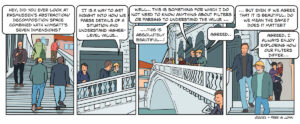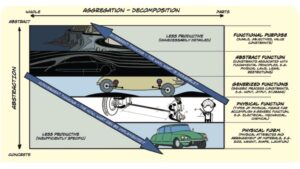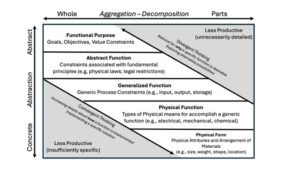
As the classical story about the blind men and the elephant illustrates - the complexity of natural systems generally exceeds our grasp. That is, from any one perspective we can only grasp a part of the elephant. Thus, to get a sense of the whole elephant it is necessary to walk around to explore each of the parts and then to mentally stitch the parts together to get a sense of the whole elephant. The different possible positions of the blind men are analogous to the different disciplines in science. Each discipline owns a part of the elephant and the challenge is to combine the various perspectives into a coherent understanding of the elephant.
However, for those who can see, there is another approach for getting a sense of the whole elephant. We can move away, increasing our distance from the elephant. As we move farther away, we can see less detail, but we can now see relations among the parts that were not visible from up close. Still, even when the whole elephant is visible, we can only see one side at a time. So, there is no single perspective that allows us to see the whole elephant. There remains the need for some cognitive work to stitch the different perspectives together into a complete understanding of the whole.
Thus, there are two ways that we can change perspectives in exploring the elephant. One way, illustrated by the blind men is through aggregation of the parts. The second way, available to those with eyes, is to change perspective through increasing distance from the elephant. This is a metaphor for abstraction.
One of the key insights of Jens Rasmussen is that to make sense of complex organizations or complex work domains it is necessary to explore through both decomposition/aggregation and through abstraction. Further, he suggests, based on observations of experts trouble shooting faults in complex technologies, that in terms of thinking productively about complex systems some regions in the abstraction/aggregation space are privileged. In particular, he suggests that at high levels of abstraction the details become less important. For example, there is limited return from reducing a functional purpose into goals, and then further reducing them into sub-goals, which can be further divided into sub-sub-goals. On the other hand, at low levels of abstraction details become more and more important. For example, the shapes of the different components have to fit together in the space available. The threads of one part have to mesh with the threads of another part. The diagrams below are intended to illustrate an exploration space for exploring complex domains jointly by abstraction and decomposition/aggregation.


The key point is that to better understand the whole elephant we have to use multiple senses and take multiple perspectives. John Boyd uses the analogy of building a snowmobile to illustrate the importance of combining an analysis mindset (e.g., exploring the components of different vehicles - motors, steering mechanisms, traction), and a synthesis mindset (e.g., recombining those components to satisfy a different purpose - driving over snow). Decomposition/aggregation reflects an analysis mindset, and abstraction reflects a synthesis mindset. The hypothesis is that to think productively about complex problems one needs to be able to move along the diagonal in this abstraction/decomposition space.

Rasmussen's design hierarchy can be used on Boyd's OODA-loop. Professor Berndt Brehmer did just that. He called his loop the DOODA-loop. He also placed the subfunctions Observe, Orient, Decide, Act as energized functions, although he called them Abstract functions and this picture Abstract Functions is in his theory called Design Criteria = constraints. Here is a q for you what are the constraints in the pictures for abstract functions? Either a classical or a more modern definition concerning command and control?
Great question. I would put the OODA elements at the level of General Functions. At the abstract function level I would consider the psychological and social constraints that impact our capacity to Observe, Orient, Decide and Act. In essence, the lawful constraints that impact our capacity to process information and to act. At the physical function level I might consider the different sensory modes along with specific sensing and computing technologies available.
Does this make sense?